Design Methods of Underwater Grounding Electrode Array by Considering Inter-Electrode Interference for Floating PVs
Abstract
:1. Introduction
2. Single Grounding Resistance Design
2.1. Modeling of Underwater Grounding Resistance
2.2. Single Grounding Resistance Design
2.3. Parallel Grounding Resistance Design
2.4. Arrangement Method of Grounding Electrodes in Floating PV Systems
3. Simulation Results and Discussion
3.1. Parallel Grounding Resistance
3.2. Application to Real Floating PV Systems
4. Conclusions
Acknowledgments
Author Contributions
Conflicts of Interest
References
- Sahu, B.K. A study on global solar PV energy developments and policies with special focus on the top ten solar PV power producing countries. Renew. Sustain. Energy Rev. 2015, 43, 621–634. [Google Scholar] [CrossRef]
- Bilgili, M.; Ozbek, A.; Sahin, B.; Kahraman, A. An overview of renewable electric power capacity and progress in new technologies in the world. Renew. Sustain. Energy Rev. 2015, 49, 323–334. [Google Scholar] [CrossRef]
- Benson, C.L.; Magee, C.L. On improvement rates for renewable energy technologies: Solar PV, wind turbines, capacitors, and batteries. Renew. Energy 2014, 68, 745–751. [Google Scholar] [CrossRef]
- Giglmayr, S.; Brent, A.C.; Gauché, P.; Fechner, H. Utility-scale PV power and energy supply outlook for South Africa in 2015. Renew. Energy 2015, 83, 779–785. [Google Scholar] [CrossRef]
- Girard, A.; Gago, E.J.; Ordoñez, J.; Muneer, T. Spain’s energy outlook: A review of PV potential and energy export. Renew. Energy 2016, 86, 703–715. [Google Scholar] [CrossRef]
- Fernandez-Jimenez, L.A.; Mendoza-Villena, M.; Zorzano-Santamaria, P.; Garcia-Garrido, E.; Lara-Santillan, P.; Zorzano-Alba, E.; Falces, A. Site selection for new PV power plants based on their observability. Renew. Energy 2015, 78, 7–15. [Google Scholar] [CrossRef]
- Wu, Y.-K.; Ye, G.-T.; Shaaban, M. Analysis of Impact of Integration of Large PV Generation Capacity and Optimization of PV Capacity: Case Studies in Taiwan. IEEE Trans. Ind. Appl. 2016, 52, 4535–4548. [Google Scholar] [CrossRef]
- Marcos, J.; Parra, Í.; García, M.; Marroyo, L. Simulating the variability of dispersed large PV plants. Prog. Photovolt. Res. Appl. 2016, 24, 680–691. [Google Scholar] [CrossRef]
- Şenol, M.; Abbasoğlu, S.; Kükrer, O.; Babatunde, A.A. A guide in installing large-scale PV power plant for self consumption mechanism. Sol. Energy 2016, 132, 518–537. [Google Scholar] [CrossRef]
- Zou, H.; Du, H.; Brown, M.A.; Mao, G. Large-scale PV power generation in China: A grid parity and techno-economic analysis. Energy 2017, 134, 256–268. [Google Scholar] [CrossRef]
- Barbose, G.; Wiser, R.; Heeter, J.; Mai, T.; Bird, L.; Bolinger, M.; Carpenter, A.; Heath, G.; Keyser, D.; Macknick, J.; et al. A retrospective analysis of benefits and impacts of U.S. renewable portfolio standards. Energy Policy 2016, 96, 645–660. [Google Scholar] [CrossRef]
- Schelly, C. Implementing renewable energy portfolio standards: The good, the bad, and the ugly in a two state comparison. Energy Policy 2014, 67, 543–551. [Google Scholar] [CrossRef]
- Tra, C.I. Have renewable portfolio standards raised electricity rates? Evidence from US electric utilities. Cont. Econ. Policy 2016, 34, 184–189. [Google Scholar] [CrossRef]
- Gürkan, G.; Langestraat, R. Modeling and analysis of renewable energy obligations and technology bandings in the UK electricity market. Energy Policy 2014, 70, 85–95. [Google Scholar] [CrossRef]
- Oak, N.; Lawson, D.; Champneys, A. Performance comparison of renewable incentive schemes using optimal control. Energy 2014, 64, 44–57. [Google Scholar] [CrossRef]
- Girish, G.P.; Sashikala, P.; Supra, B.; Acharya, A. Renewable energy certificate trading through power exchanges in India. Int. J. Energy Econ. Policy 2015, 5, 805–808. [Google Scholar]
- Amrutha, A.A.; Balachandra, P.; Mathirajan, M. Role of targeted policies in mainstreaming renewable energy in a resource constrained electricity system: A case study of Karnataka electricity system in India. Energy Policy 2017, 106, 48–58. [Google Scholar] [CrossRef]
- Sun, P.; Nie, P. A comparative study of feed-in tariff and renewable portfolio standard policy in renewable energy industry. Renew. Energy 2015, 74, 255–262. [Google Scholar] [CrossRef]
- Dusonchet, L.; Telaretti, E. Comparative economic analysis of support policies for solar PV in the most representative EU countries. Renew. Sustain. Energy Rev. 2015, 42, 986–998. [Google Scholar] [CrossRef]
- Lyu, H.; Li, H.; Wallin, F.; Xv, B. Research on Chinese Solar photovoltaic development based on green-trading mechanisms in power system by using a system dynamics model. Energy Procedia 2017, 105, 3960–3965. [Google Scholar] [CrossRef]
- Government 24. Available online: https://www.gov.kr/portal/ntnadmNews/1279625 (accessed on 3 April 2018).
- Choi, Y.K. A study on power generation analysis of floating PV system considering environmental impact. Int. J. Softw. Eng. Appl. 2014, 8, 75–84. [Google Scholar] [CrossRef]
- New·Renewable Energy Center in the Korea Energy Management Corporation. Available online: http://www.knrec.or.kr/business/rps_guide.aspx (accessed on 3 April 2018).
- Yadav, N.; Gupta, M.; Sudhakar, K. Energy assessment of floating photovoltaic system. In Proceedings of the International Conference on Electrical Power and Energy Systems (ICEPES), Bhopal, India, 14–16 December 2016; pp. 264–269. [Google Scholar]
- Ho, C.J.; Chou, W.; Lai, C. On improvement rates for renewable energy technologies: Solar PV, wind turbines, capacitors, and batteries. Energy Convers. Manag. 2015, 89, 862–872. [Google Scholar] [CrossRef]
- Cazzaniga, R.; Cicu, M.; Rosa-Clot, M.; Rosa-Clot, P.; Tina, G.M.; Ventura, C. Floating photovoltaic plants: Performance analysis and design solutions. Renew. Sustain. Energy Rev. 2017, 81, 1730–1741. [Google Scholar] [CrossRef]
- Kim, S.H.; Yoon, S.J.; Choi, W. Design and Construction of 1 MW Class Floating PV Generation Structural System Using FRP Members. Energies 2017, 10, 1142. [Google Scholar] [CrossRef]
- Ferrer-Gisbert, C.; Ferrán-Gozálvez, J.J.; Redón-Santafé, M.; Ferrer-Gisbert, P.; Sánchez-Romero, F.J.; Torregrosa-Soler, J.B. A new photovoltaic floating cover system for water reservoirs. Renew. Energy 2013, 60, 63–70. [Google Scholar] [CrossRef]
- Yoo, J.H.; Kim, S.H.; An, D.J.; Choi, W.C.; Yoon, S.J. Generation Efficiency of Tracking Type Floating PV Energy Generation Structure Using Fiber Reinforced Polymer Plastic (FRP) Members. Key Eng. Mater. 2017, 730, 212–217. [Google Scholar] [CrossRef]
- Kim, D.U.; Cho, M.H.; Kim, H.S.; Shin, D.S.; Ryu, K.H.; Kim, C.H. Design and A Safety Analysis and Assessment of a Grounding System according to International Standards. J. Korean Inst. Illum. Electr. Install. Eng. 2015, 29, 54–59. [Google Scholar] [CrossRef]
- National Law Information Center. Available online: http://www.law.go.kr/lsStmdInfoP.do?lsiSeq=172223 (accessed on 3 April 2018).
- Ko, J.W.; Cha, H.L.; Kim, D.K.-S.; Lim, J.R.; Kim, G.G.; Bhang, B.G.; Won, C.S.; Jung, H.S.; Kang, D.H.; Ahn, H.K. Safety Analysis of Grounding Resistance with Depth of Water for Floating PVs. Energies 2017, 10, 1304. [Google Scholar] [CrossRef]
- Gil, H.J.; Kim, D.O.; Choi, C.S. Research on Assessment of Potential Interference between Individual Grounding Electrodes Using an Electrolytic Tank Modeling Method. J. Korean Inst. Illum. Electr. Install. Eng. 2008, 22, 27–33. [Google Scholar] [CrossRef]
- Tagg, G.F. Measurement of earth-electrode resistance with particular reference to earth-electrode systems covering a large area. Proc. Inst. Electr. Eng. 1964, 111, 2118–2130. [Google Scholar] [CrossRef]
- Campbell, R.B.; Bower, C.A.; Richards, L.A. Change of electrical conductivity with temperature and the relation of osmotic pressure to electrical conductivity and Ion concentration for soil Extracts1. Soil Sci. Soc. Am. J. 1949, 13, 66–69. [Google Scholar] [CrossRef]
- Tagg, G.F. Earth Resistances; Pitman Publishing Corporation: New York, NY, USA, 1964; p. 106. [Google Scholar]
- Dawalibi, F.; Mukhedkar, D. Multi step analysis of interconnected grounding electrodes. IEEE Trans. Power App. Syst. 1976, 95, 113–119. [Google Scholar] [CrossRef]

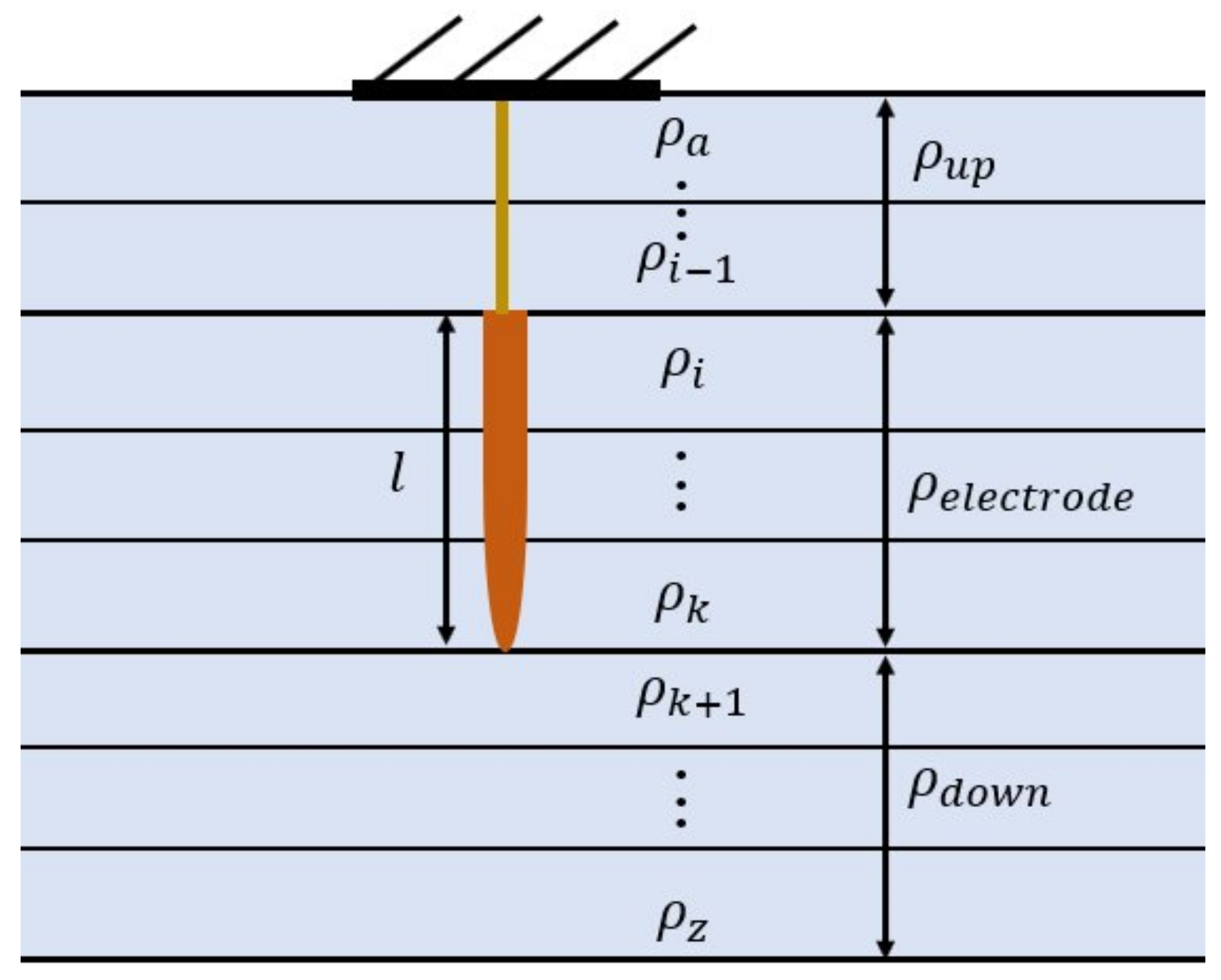
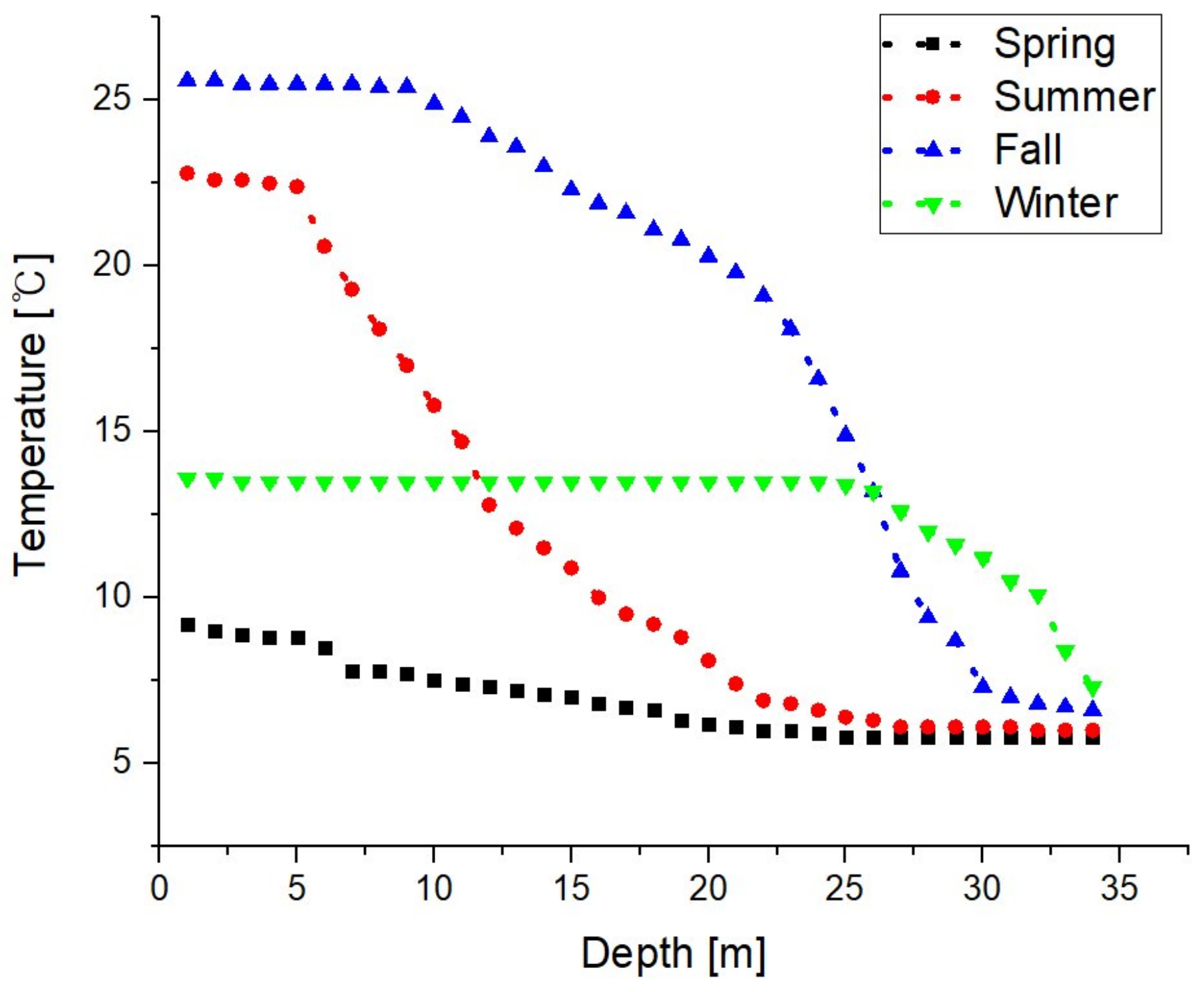

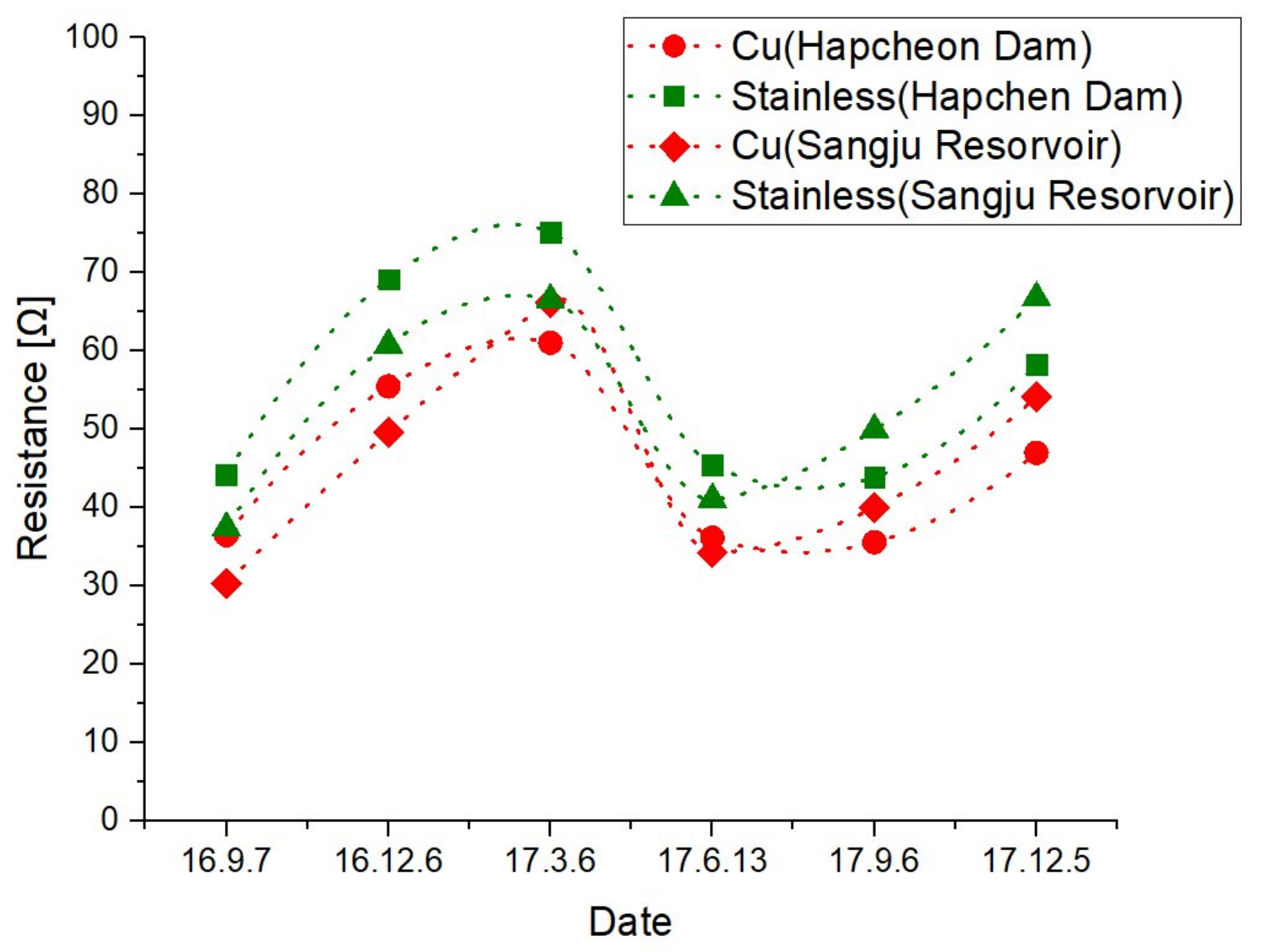

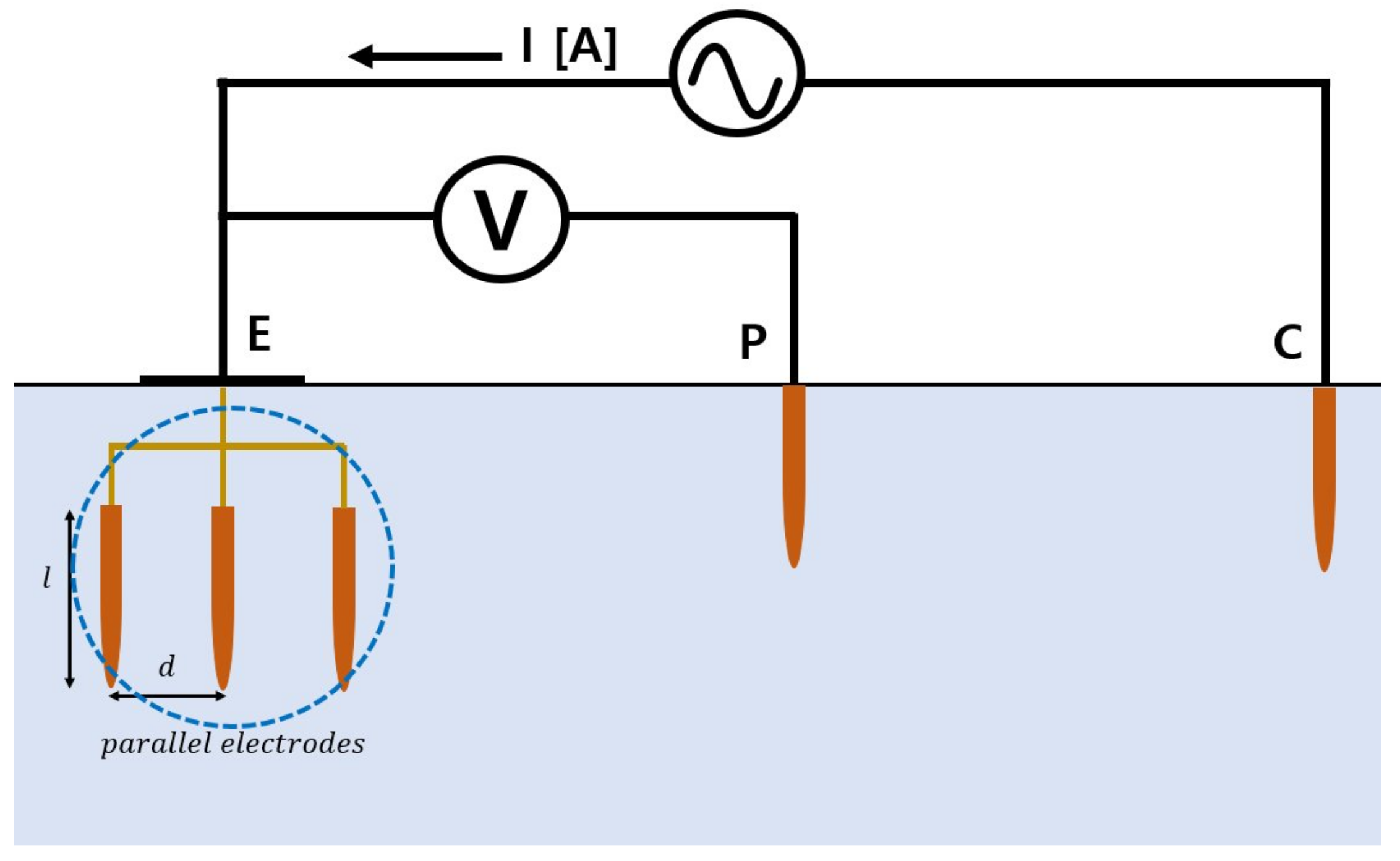
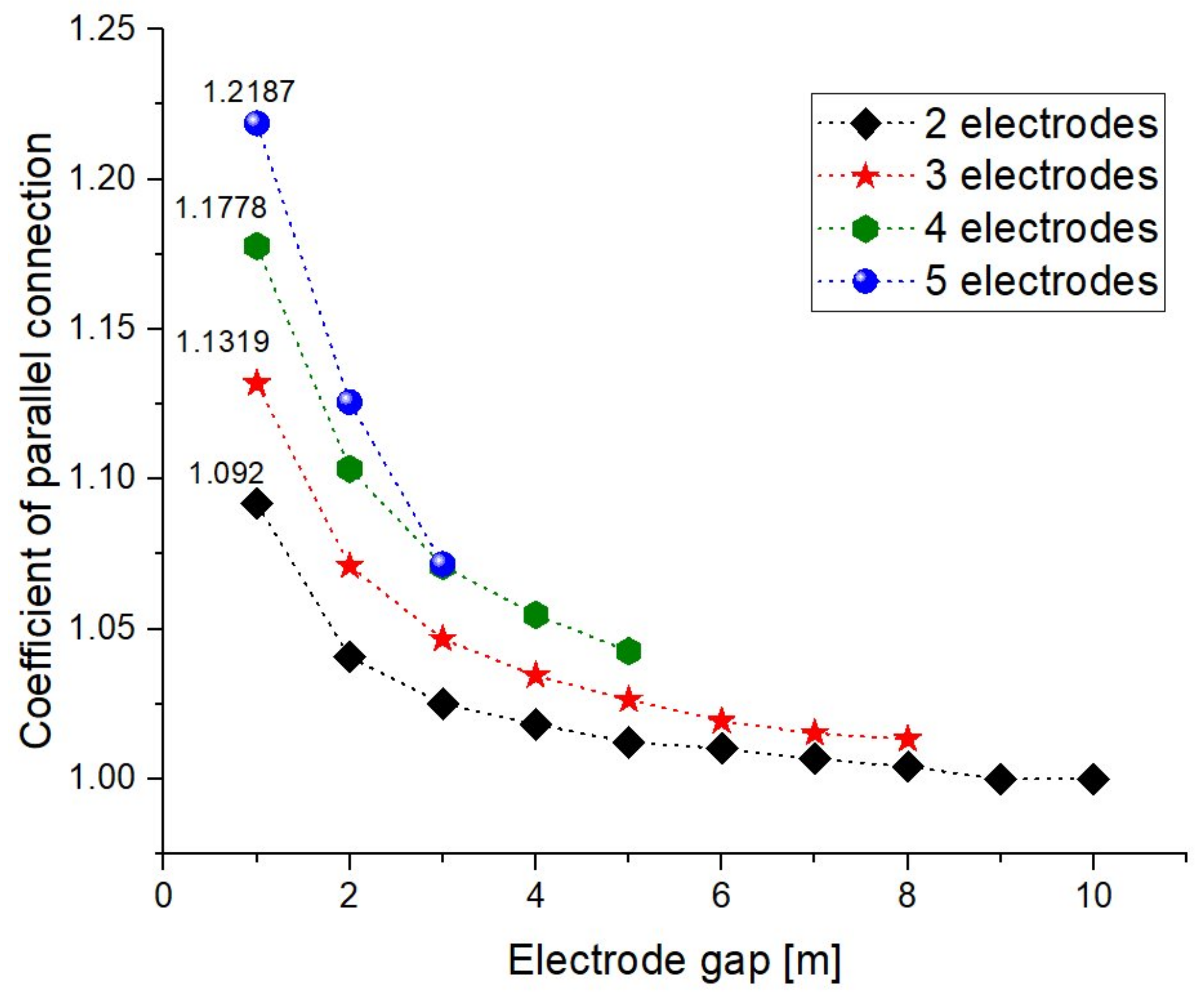

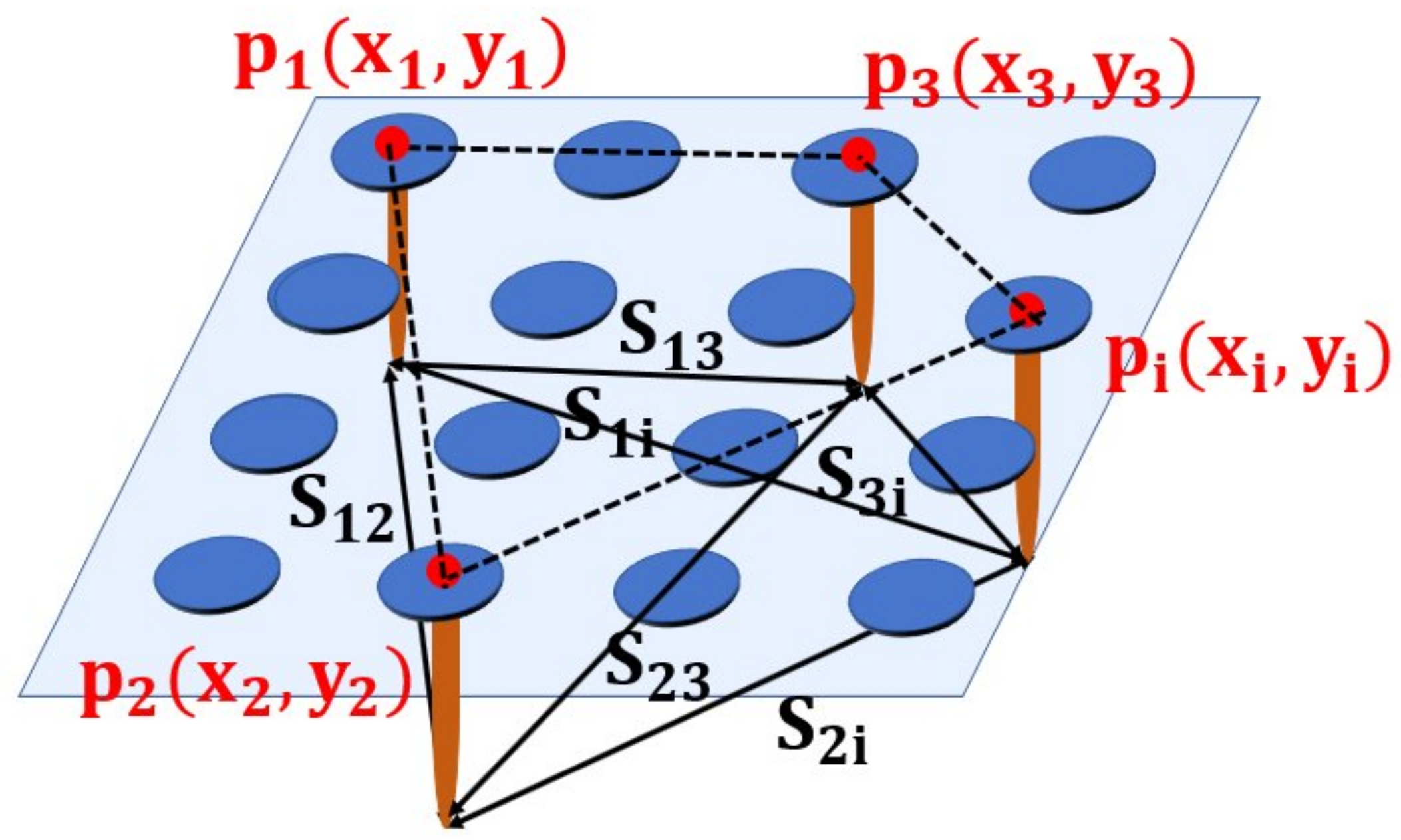
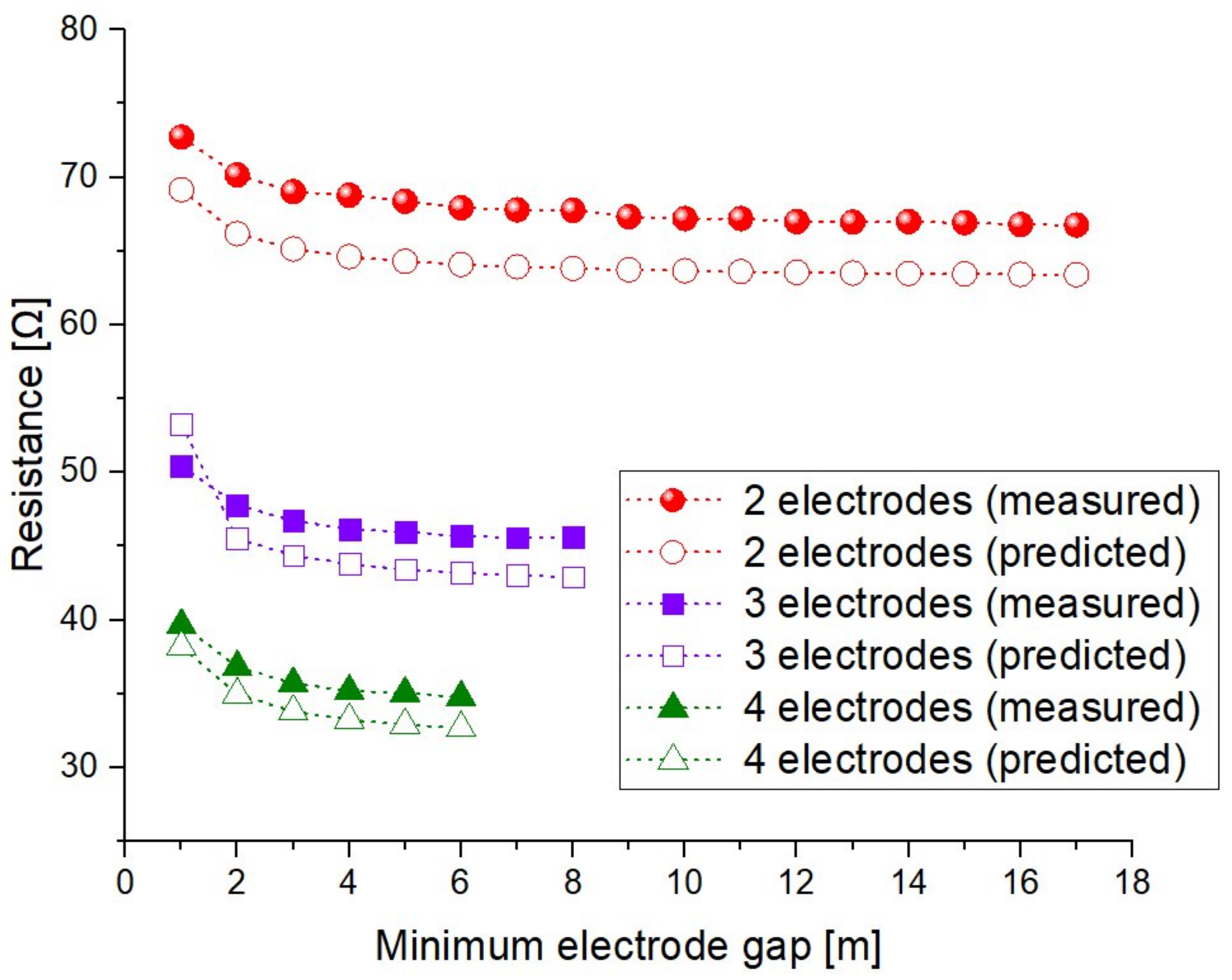


| Type | Arrangement | Maximum Distance | Required Area |
|---|---|---|---|
| Linear |  | ||
| Quadrangle |  | ⋮ | |
| Ring | 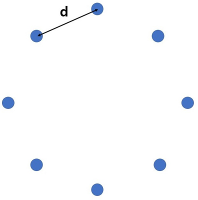 | ⋮ |
| Classification of Scale (Comparative) | Arrangement Method | Capacity (kW) | Electrode Gap (m) | No. of Electrode | Length of Electrode (m) | Underwater Grounding Resistance |
|---|---|---|---|---|---|---|
| Mid-scale | Linear (Figure 12a) | 100 | 10 | 14 | 0.5 | 9.41 |
| Mid-scale | Quadrangle (Figure 12b) | 100 | 10 | 14 | 0.5 | 9.51 |
| Small-scale | Matrix Array (4 × 4) (Figure 13a) | 3 | 2 | 16 | 0.5 | 11.53 |
| Small-scale | Quadrangle (Figure 13b) | 3 | 3 | 6 | 1.8 | 9.53 |
| Large-scale | Linear (Figure 12a) | Over 100 | Over 10 | 14 | 0.5 | Under 9.41 |
© 2018 by the authors. Licensee MDPI, Basel, Switzerland. This article is an open access article distributed under the terms and conditions of the Creative Commons Attribution (CC BY) license (http://creativecommons.org/licenses/by/4.0/).
Share and Cite
Bhang, B.G.; Kim, G.G.; Cha, H.L.; Kim, D.K.; Choi, J.H.; Park, S.Y.; Ahn, H.K. Design Methods of Underwater Grounding Electrode Array by Considering Inter-Electrode Interference for Floating PVs. Energies 2018, 11, 982. https://doi.org/10.3390/en11040982
Bhang BG, Kim GG, Cha HL, Kim DK, Choi JH, Park SY, Ahn HK. Design Methods of Underwater Grounding Electrode Array by Considering Inter-Electrode Interference for Floating PVs. Energies. 2018; 11(4):982. https://doi.org/10.3390/en11040982
Chicago/Turabian StyleBhang, Byeong Gwan, Gyu Gwang Kim, Hae Lim Cha, David Kwangsoon Kim, Jin Ho Choi, So Young Park, and Hyung Keun Ahn. 2018. "Design Methods of Underwater Grounding Electrode Array by Considering Inter-Electrode Interference for Floating PVs" Energies 11, no. 4: 982. https://doi.org/10.3390/en11040982





